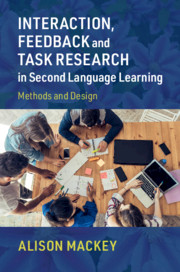Book contents
- Interaction, Feedback and Task Research in Second Language Learning
- Interaction, Feedback and Task Research in Second Language Learning
- Copyright page
- Dedication
- Contents
- Figures
- Tables
- Preface
- Chapter One Theory and Approaches in Research into Interaction, Corrective Feedback, and Tasks in L2 Learning
- Chapter Two Designing Studies of the Roles of Interaction, Feedback, and Tasks in Second Language Learning
- Chapter Three Investigating Individual Differences in Interaction, Feedback, and Task Studies: Aptitude, Working Memory, Cognitive Creativity, and New Findings in L2 Learning
- Chapter Four Collecting Introspective Data in Interaction, Feedback, and Task Research
- Chapter Five Creating and Using Surveys, Interviews, and Mixed Methods for Research into Interaction, Corrective Feedback, Tasks, and L2 Learning
- Chapter Six Doing Meta-Analytic and Synthetic Research on Interaction, Feedback, Tasks, and L2 Learning
- Chapter Seven Investigating Interaction, Feedback, Tasks, and L2 Learning in Instructional Settings
- Chapter Eight Choosing and Using Eye-Tracking, Imaging, and Prompted Production Measures to Investigate Interaction, Feedback, and Tasks in L2 Learning
- Chapter Nine Working with Data in Interaction, Feedback, and Task Research
- Chapter Ten Common Problems, Pitfalls, and How to Address Them in Research on Interaction, Corrective Feedback, and Tasks in L2 Learning
- Glossary
- References
- Index
Chapter Three - Investigating Individual Differences in Interaction, Feedback, and Task Studies: Aptitude, Working Memory, Cognitive Creativity, and New Findings in L2 Learning
Published online by Cambridge University Press: 03 August 2020
- Interaction, Feedback and Task Research in Second Language Learning
- Interaction, Feedback and Task Research in Second Language Learning
- Copyright page
- Dedication
- Contents
- Figures
- Tables
- Preface
- Chapter One Theory and Approaches in Research into Interaction, Corrective Feedback, and Tasks in L2 Learning
- Chapter Two Designing Studies of the Roles of Interaction, Feedback, and Tasks in Second Language Learning
- Chapter Three Investigating Individual Differences in Interaction, Feedback, and Task Studies: Aptitude, Working Memory, Cognitive Creativity, and New Findings in L2 Learning
- Chapter Four Collecting Introspective Data in Interaction, Feedback, and Task Research
- Chapter Five Creating and Using Surveys, Interviews, and Mixed Methods for Research into Interaction, Corrective Feedback, Tasks, and L2 Learning
- Chapter Six Doing Meta-Analytic and Synthetic Research on Interaction, Feedback, Tasks, and L2 Learning
- Chapter Seven Investigating Interaction, Feedback, Tasks, and L2 Learning in Instructional Settings
- Chapter Eight Choosing and Using Eye-Tracking, Imaging, and Prompted Production Measures to Investigate Interaction, Feedback, and Tasks in L2 Learning
- Chapter Nine Working with Data in Interaction, Feedback, and Task Research
- Chapter Ten Common Problems, Pitfalls, and How to Address Them in Research on Interaction, Corrective Feedback, and Tasks in L2 Learning
- Glossary
- References
- Index
Summary
Interaction, feedback, and task researchers often want to know more about the nature of the cognitive processes that occur while language learners are being exposed to second or foreign languages. This applies when learners are hearing (or sometimes reading) or producing language that occurs in interaction and the feedback that results, and often tasks are part of their experiences. In other words, we want to know what is going on inside learners’ heads because we believe this might help us understand more about language learning. We differentiate between learners’ minds (cognition tools) and their brains, where we focus on imaging. I discuss imaging in the next chapter because importantly (and perhaps strangely), the mind and brain are not usually considered to be isomorphic. Interaction, feedback and task researchers typically turn to cognitive and psycholinguistics-based research tools to help us uncover information about individual differences and their relation to learning.
- Type
- Chapter
- Information
- Interaction, Feedback and Task Research in Second Language LearningMethods and Design, pp. 54 - 70Publisher: Cambridge University PressPrint publication year: 2020



